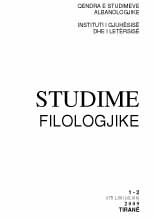“Kanuni total” tek Prilli i thyer
“The total canon” in “Broken April”
Author(s): Shaban SinaniSubject(s): Language and Literature Studies
Published by: Qendra e Studimeve Albanologjike
Keywords: The total canon; Broken April; Albania; Albanian Language
Summary/Abstract: The novel “April in ending” (“Broken April”) is considered like an illustration of the brilliance of the canon’s honor and virtue of the literal studies tradition in and out of the country. Like always happens in Kadare’s prose, the canon in this book isn’t a conditional text, an “avant-texte”. The writer is often directed to the end of medievalism in order to discover the early European Albania. Following the same attitude to the past, the writer if he had the purpose to highlight the national European right, he would have found in the epoch of humanism a strong and brilliant tradition: the consuetudinary tradition of preottoman Albanian cities. But, the writer avoids this tradition, because his only purpose in “April in ending” is to decrypt, to decode it and to build some parallels with the epoch when he was living. The men’s life under the Canon (alb. “Kanun”) is the life of someone imprisoned of him. The same as the power of the Canon in 1930 is the ideology which ruled from 1970 to 1980. The Canon’s men isn’t the virtue men and the equestrian honor, like he’s being presented in some scientific studies, but a fatal being who doesn’t have any power. He has to think with the Canon, to say hi with the Canon, to take a place in the room like the Canon previses, to be a strong man with the Canon, to kill with the Canon, to die with it. The Canon is the conscience and the subconscience, is an ideology and a moral for everybody, is power and obedience. The entire book describes the fatality to life men’s existence, like Merceault in “The Foreigner” of J. Camus, kills even he’s not a criminal, he just kills because he has to. In “April in ending” the Canon isn’t brilliant at all. It is just terrible. This book produces the “bloods industry”, which is fiercely described by the author. If we want to compare the book with the Canon, we can say that the Canon represents a genotext. It just can be cited or voiced through the characters thoughts and acts. The writer stays far away from the Canon itself. Gjorg, Besian Vorpsi, Mark Ukacjerra, the prince and the king are under the Canon’s weight of the fear, magic and power. The only character who refuses the fake brilliance of Canon is Diana. She breaks the Canon in front of its most famous interpreter Binak Alia and she enters in an isolation tower where a woman had never entered before. She enters in the “death ring” hoping that she will meet there in her last days of life, him, the men with the black sign in his arm. Like Clelia did in “La Chartreuse de Parma”, who contemns every obstacle or ethics code and finds herself in the same cell as Fabrizio, right in the moment when she’s informed that he was poisoned and he had just a few hours of life, Diana with the same contemn to the Canon, enters in the isolation tower to meet Gjorg who’s waiting the gong of the last day of his life and to forward the genes of his life.
Journal: Studime Filologjike
- Issue Year: 2009
- Issue No: 01-02
- Page Range: 119-147
- Page Count: 29
- Language: Albanian
- Content File-PDF

